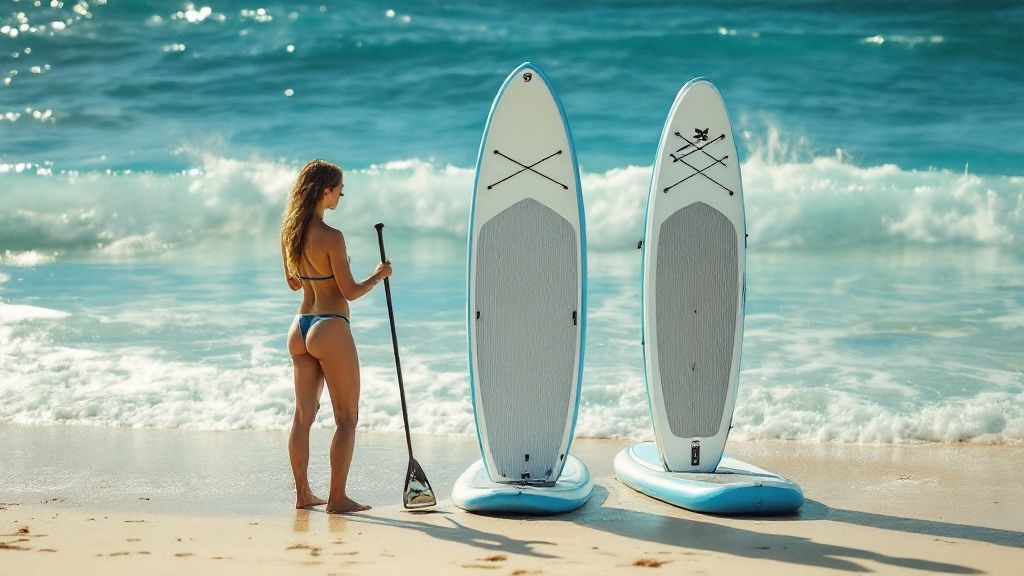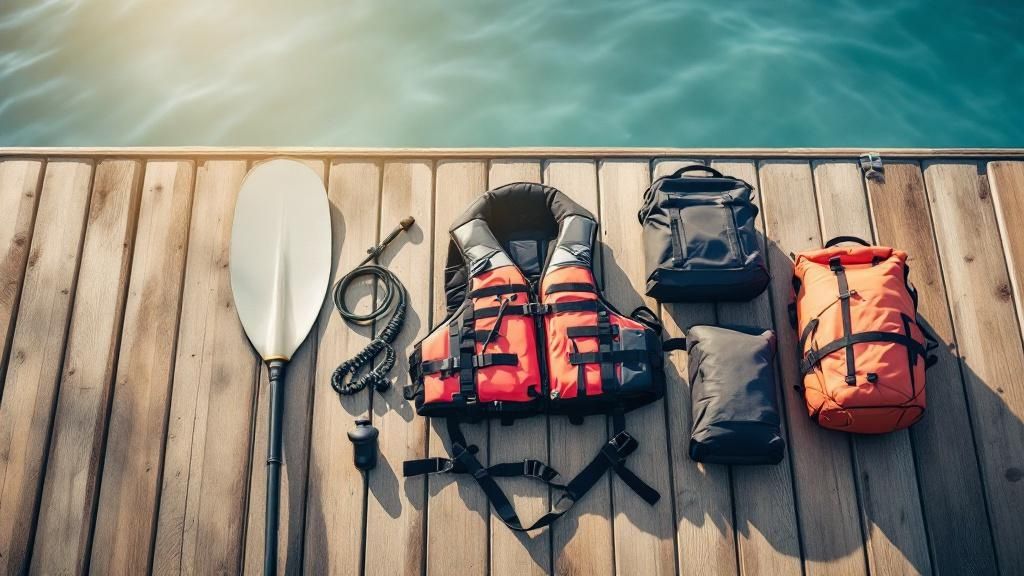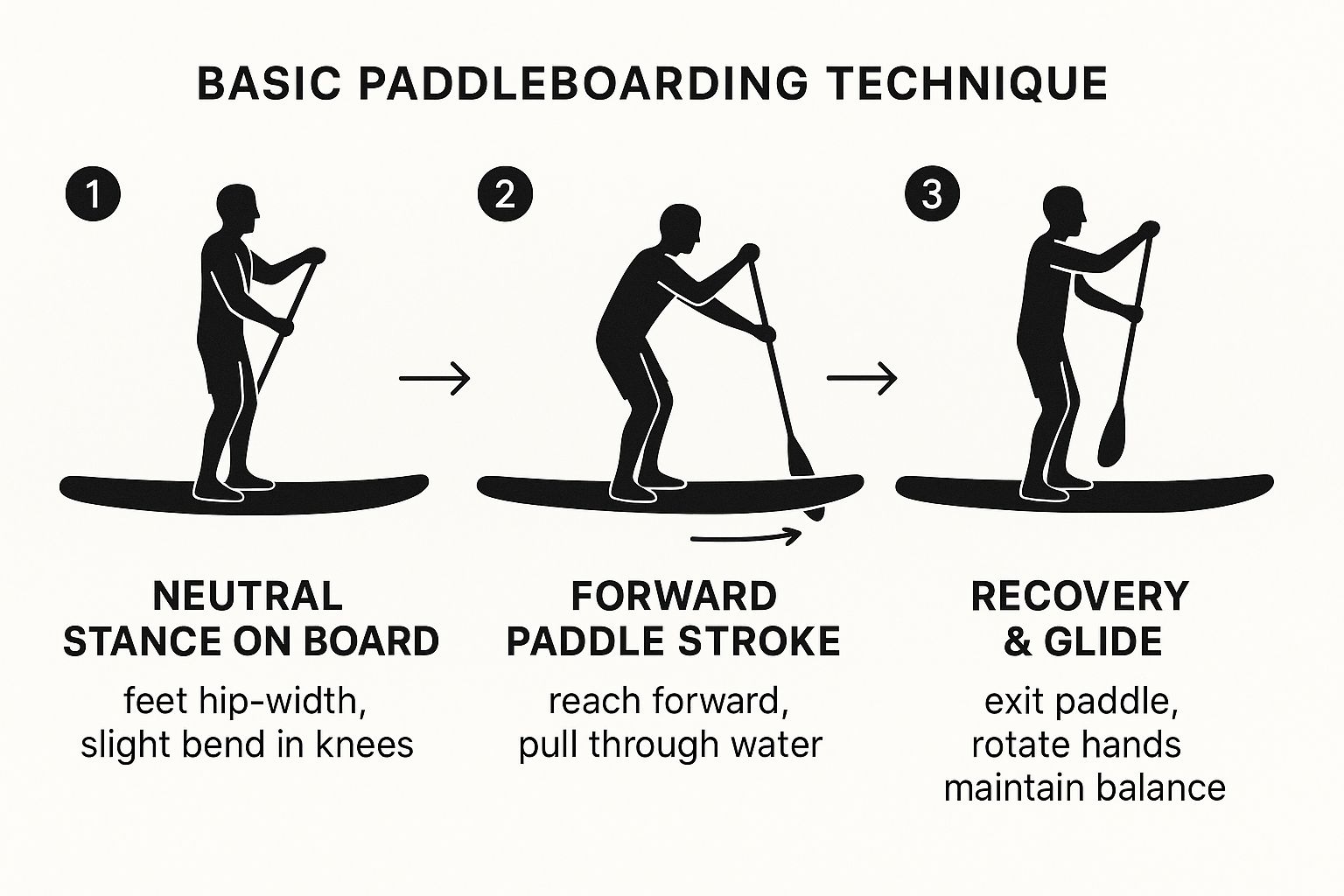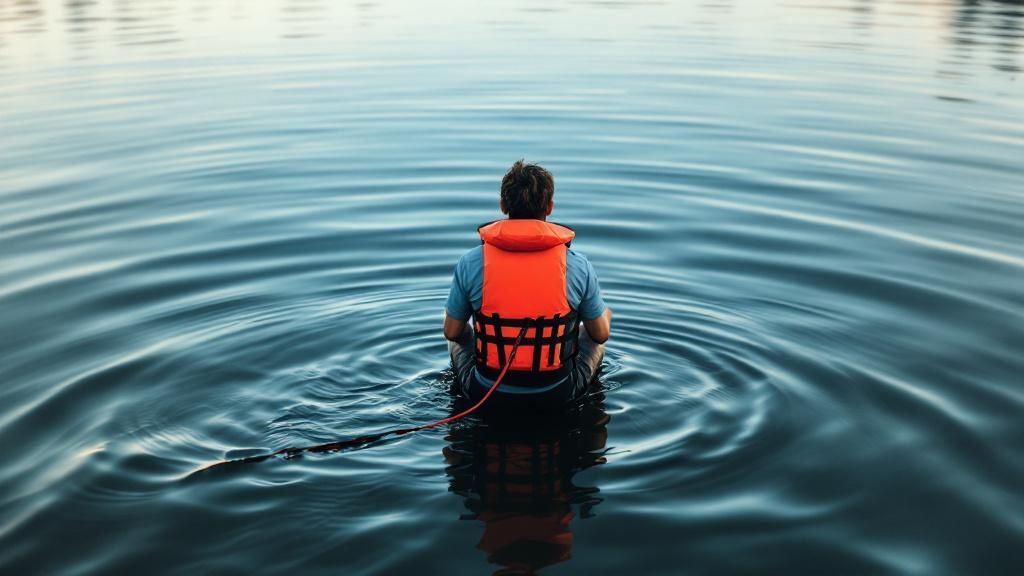Paddle Boards How To A UK Beginner's Guide

Getting into paddle boarding is far simpler than it looks. It really just boils down to a few key decisions: picking between an inflatable or a hard board, learning the basic setup, and getting a feel for the paddling technique. Honestly, the right board choice depends entirely on your lifestyle, from how much storage space you have to how you plan on getting it to the water. A practical example would be choosing a lightweight Loco inflatable if you live in a third-floor flat with no lift, versus a performance hardboard if you have a garage and live by the coast.
Your Launchpad into Stand Up Paddleboarding

Welcome to the world of stand up paddleboarding (SUP). It’s easy to see why so many people across the UK are drawn to paddling on everything from serene Scottish lochs to the vibrant Cornish coast. The sport has seen a massive surge in popularity, becoming a common sight on British waterways.
The growth has been pretty remarkable. By 2023, it was estimated that around 250,000 UK residents had tried paddleboarding at least once, a huge jump from fewer than 100,000 just a decade earlier. This boom really highlights the need for clear, practical guidance for anyone just starting out.
Inflatable vs Hard Boards: The First Big Choice
Your first major decision is choosing between an inflatable or a hard board. This isn't just about how it performs on the water; it’s about pure practicality and how the board is going to fit into your actual life. If you want to dive deeper into what is paddle boarding and all its benefits, our detailed guide is a great place to start.
Let’s look at the real-world differences:
- Inflatable SUPs: These are the undisputed champions of convenience. An inflatable board like the Loco Amigo Air packs down into a backpack. This makes it perfect if you live in a city flat with limited storage. For example, you can easily pop it in the boot of your Ford Fiesta or even take it on a train to the coast.
- Hard SUPs: These boards offer superior performance, glide, and responsiveness once you're on the water. They are always ready to go—no pumping required. If you've got a garage or van for storage and a way to transport it, a hardboard like the Loco El Diablo provides an unmatched experience for aspiring paddlers who want to progress in surf or distance paddling.
The best board for you is the one you’ll use most often. An incredibly high-performance board is useless if it spends all its time in storage because it's too much of a faff to get to the water.
Inflatable vs Hard Paddle Board Quick Comparison
To help you decide which type of board best suits your needs, from storage to on-water performance, here's a quick summary.
| Feature | Inflatable SUP (e.g., Loco Amigo Air) | Hard SUP (e.g., Loco El Diablo) |
|---|---|---|
| Storage | Packs down into a large backpack, easy to store in a cupboard or small space. | Requires significant space like a garage, shed, or van. |
| Transport | Fits in any car boot, can be taken on public transport or even planes. | Needs a roof rack or a large van for transport. |
| Durability | Very tough against dings and drops due to its construction. | Can be prone to chips or cracks if knocked against hard surfaces. |
| Performance | Good for all-around use and cruising, but can feel less rigid and slower. | Offers better glide, speed, and responsiveness, especially in surf. |
| Setup Time | Needs to be unrolled and inflated, which takes about 5-10 minutes. | Ready to go instantly. Just grab it and head to the water. |
| Best For | Beginners, those with limited storage, and travellers. | Paddlers focused on performance, surfing, or racing; those with ample storage. |
Ultimately, your choice comes down to balancing convenience with performance. Neither is "better" overall; it's about what's better for you.
Thinking About Your Lifestyle
Don't just get bogged down in features; think about the logistics of your life. Ask yourself some practical questions. How easily can I store it? How will I get it from my house to the beach or river?
A family living in a terraced house in Brighton, for instance, might find a Loco inflatable package ideal for weekend trips to the coast. On the other hand, someone living moments from the sea in Newquay with a van would probably prefer the grab-and-go convenience of a hardboard for a quick after-work surf.
This guide is designed to give you that foundational knowledge to choose wisely, ensuring you feel confident before your very first paddle.
How to Choose Your First Paddle Board and Gear

Diving into the world of paddleboarding is exciting, but picking your first board can feel a bit daunting. Don't worry, it doesn't have to be complicated. When you're just starting out, the absolute top priority is feeling stable and confident on the water. It really all boils down to three things: stability, volume, and size.
A board's stability is almost entirely down to its width. For any beginner, a wider board provides a much more forgiving platform, making it heaps easier to find your balance. Imagine trying to walk along a narrow beam versus a wide path – it’s the same principle. The wider surface just gives you that extra bit of grace.
For instance, a great all-round inflatable board like the Loco Amigo Air is typically over 32 inches wide. This offers loads of stability while you're getting the hang of things. A narrower, racier board might look cool and go faster, but it'll feel incredibly tippy and could easily turn your first few trips out into a frustrating wobble-fest.
Understanding Board Volume and Size
Volume, which we measure in litres, is simply a way of talking about how much weight a board can support while staying buoyant and stable. It’s directly linked to your own body weight. If a board has too little volume for you, it'll sit low in the water, feel unstable, and be a real slog to paddle.
Getting the size and volume right is absolutely crucial for having a good time. A heavier rider is going to need a board with more volume to feel secure, whereas a lighter person can get away with a smaller, more nimble board. For a really detailed breakdown, we've put together a complete guide on how to choose the right paddle board for your height and weight.
Here in the UK, the sheer practicality of inflatable boards has seen them absolutely dominate the market, now accounting for nearly 70% of sales. Their easy storage is a godsend if you're short on space, and modern drop-stitch fabric means they are surprisingly rigid when pumped up correctly. This boom is part of a massive global trend, with the market expected to hit USD 3.1 billion by 2035.
Don't Forget the Essential Gear
Your board might be the main event, but it's only one part of the puzzle. To get out on the water safely and actually move, you'll need three other non-negotiable bits of kit.
- A Paddle: Think of your paddle as your engine. Most starter packages, like those from Loco, include an adjustable aluminium or fibreglass paddle. A brilliant tip for getting the height right is to stand it up vertically; the handle should just reach your wrist when you stretch your arm straight above your head.
- A Leash: This is a vital piece of safety equipment that tethers your ankle to the board. If you take a tumble – and you will – the leash stops your board from being swept away by wind or current. Remember, your board is your biggest flotation device!
- A Personal Flotation Device (PFD): A PFD, like a buoyancy aid or life jacket, gives you that extra bit of float and is highly recommended for all paddlers. For calm, flat water, many people prefer a compact waist-belt PFD which can be inflated manually if you get into trouble.
Getting your board and gear sorted from day one is the secret to a safe, fun, and much less wobbly introduction to paddleboarding. Focus on finding a stable board first, and everything else will fall into place.
Getting Your Inflatable SUP Ready for the First Time
Right, let's get your board from backpack to water-ready. Turning a rolled-up inflatable SUP into a solid craft is pretty straightforward, but a couple of key details make a world of difference. We'll use a complete package, like a Loco inflatable, as our example to walk through the setup.
First things first, find a decent patch of ground to unroll your board – grass is perfect. Try to avoid dragging it across sharp stones or rough concrete. A practical example is using the board's own bag as a groundsheet if you're setting up on a gravelly car park, protecting your investment before it even hits the water.
This infographic gives you a quick look at the basic paddling motion you'll be using once you're all set up.

Getting these three movements down – stance, stroke, and recovery – is really the secret sauce to paddling efficiently and actually enjoying your time out there.
Getting the Inflation Right
Before you even connect the pump, locate the valve on your board and have a quick look at the central pin. Give it a press and a twist so it pops up. This 'up' position is crucial; it creates a one-way seal that lets air in but stops it all from rushing back out the second you disconnect the pump. Honestly, this simple check will save you a world of frustration.
Now, connect the pump hose with a firm push-and-twist motion until it’s secure. Time to start pumping. As you go, keep a close eye on the pressure gauge. A classic rookie mistake is stopping too soon, leaving the board feeling soft and saggy.
An under-inflated board will feel like you're trying to balance on a blancmange. It'll bend in the middle, making it incredibly wobbly and unstable. Hitting the recommended PSI isn’t just a suggestion; it’s absolutely essential for the board to perform properly and give you a rigid, stable platform.
For most all-round boards, including those from Loco, you're aiming for somewhere between 15-18 PSI (Pounds per Square Inch). The last few pumps will feel like a proper workout, but you've got to push through to hit that target pressure. It’s what gives the board its stiffness.
Installing Your Fin and Leash
With the board now rock-solid, it's time to pop the fin in. This little piece is vital for tracking, which is just a fancy way of saying paddling in a straight line. Most inflatable SUPs, including Loco boards, use a dead simple slide-and-clip system. Just slide the fin into its box on the underside of the board and lock it in place with the small clip.
Lastly, and most importantly, attach your leash. This is your number one piece of safety kit. Loop one end through the D-ring at the tail of your board and fasten the velcro securely. The other end, the comfy padded cuff, goes around your ankle or just below your knee. Now you're safely tethered to your board and ready to hit the water.
For more on staying safe out there, the RNLI offers some excellent water safety advice that's well worth a read.
Getting to Grips with Your Paddling Technique
Right, this is the fun bit – actually getting out on the water. Your first real challenge is simply getting from the shore onto your board, but honestly, it's easier than you might think.
First up, walk your board out until the water is at least knee-deep. This is crucial because it stops your fin from getting scraped or, even worse, snapped off on the bottom. Once you're deep enough, lay your paddle flat across the deck of the board, right in front of where you'll be. Now, climb on from the side, aiming for a kneeling position slap-bang in the centre. The carry handle is your perfect marker for this.
From Kneeling to Standing
Take a moment. Get comfortable kneeling and just feel how the board moves underneath you. Have a few gentle paddles on each side to get used to the response. Feeling steady? Great, let's get you standing.
Lay your paddle across the board again, and place your hands flat on the deck, about shoulder-width apart, like you're in a tabletop position. Now, bring one foot forward to where your knee was, followed by the other. The absolute golden rule here is to keep your eyes fixed on the horizon, not down at your feet or the board. Looking down is a surefire way to lose your balance.
With your feet roughly hip-width apart and a slight bend in your knees, slowly bring your chest up and stand tall. Pick up your paddle, and you’re away! Don't panic if you feel a bit wobbly; that happens to everyone at first. Just keep your core tight and your gaze forward.
Pro Tip: Here’s a little mental trick that makes a huge difference. Instead of thinking about pulling the paddle through the water, imagine planting your paddle blade and pulling the board past it. This simple shift forces you to use your bigger core muscles rather than just your arms, giving you a much more powerful and efficient stroke that won't tire you out.
The Three Phases of the Forward Stroke
Good paddling is all about technique, not just raw power. A solid forward stroke is your engine, and it’s what will get you gliding across the water. To really nail this and improve your balance, it's well worth doing some exercises to strengthen your core muscles. Your stroke can be broken down into three simple phases:
- The Catch: Hinge forward at your hips, reach out, and plant the entire blade of your paddle in the water. Your bottom arm should be pretty straight, with your top hand over the handle, pushing the paddle downwards.
- The Power Phase: This is where the real work happens. Fire up your core and back muscles to pull your body and the board forward, past where you planted the paddle. Try to keep the paddle shaft as vertical as you can – that's your ticket to maximum efficiency. The power should come from a twist in your torso, not just yanking with your arms.
- The Recovery: As soon as the paddle blade gets to your feet, lift it cleanly out of the water. Let your paddle swing forward in a smooth, relaxed motion, ready for the next catch.
For a practical example, imagine you are trying to reach over a kitchen counter to grab something just out of reach – that's the kind of hinge and reach you want for 'The Catch'.
How to Steer Your Board
Paddling straight is one thing, but you'll need to turn eventually. The easiest and most effective way to do this is with a sweep stroke. It’s pretty much what it sounds like: a big, sweeping arc instead of a straight pull.
- To turn right: Plant your paddle blade way out on the left side of your board. Then, 'sweep' it in a wide arc back towards the tail. Imagine you're drawing a giant letter 'C' in the water with your paddle.
- To turn left: Just do the opposite. Plant the blade far out on your right and sweep it back towards the tail.
The wider you make that arc, the sharper you'll turn. Getting these basic strokes dialled in will give you all the confidence you need to get out there and start exploring.
Essential Safety and Water Awareness

Paddling safely is paddling confidently. Moving beyond technique, this part is about getting you ready for real-world water conditions, making sure every trip is a good one. Honestly, knowing what to expect before you even dip a paddle in the water is the most important skill you can learn.
Your first port of call, every single time, should be the weather forecast. You need to pay special attention to the wind speed and direction. An offshore wind—one blowing from the land out to sea—is a massive hazard for paddleboarders. For a practical example, a gentle-seeming breeze on the beach at Brighton can quickly push an unsuspecting paddler out towards the Rampion Wind Farm, making for a dangerous and exhausting paddle back.
Reading the Water
Understanding the local conditions is just as vital as checking the forecast. Tides, currents, and river flow can completely change your paddle session. If you're heading to the coast, always check the tide times; a strong outgoing tide can turn a gentle paddle back to shore into a proper battle.
Always tell someone where you're going and when you expect to be back. This simple step, your 'paddle plan', is a critical safety net. It means if you get into trouble, someone knows where to start looking for you.
A skill every single paddler needs to practise is the self-rescue. Falling in is just part of the sport, and you have to know how to get back on your board from deep water without panicking.
Here’s a straightforward way to get back on:
- Get yourself alongside your board, right near the centre carry handle.
- Reach across the board, grabbing the handle or the far edge with both hands.
- Kick your legs hard behind you to get them up to the surface, just like you're swimming.
- Use that momentum to pull your chest and torso up onto the board.
- Swing one leg on, then the other, and shuffle back into the middle.
Sharing the Waterways
Remember, the UK's waterways are shared spaces. Get to know the 'rules of the road' to avoid any close calls with kayakers, sailors, and motorboats. The general idea is to stay to the right of channels and always give way to larger, less manoeuvrable vessels. For a deeper dive, our guide to essential paddleboarding safety tips has even more detail.
Alongside water safety, it's a great idea for any outdoor enthusiast to be clued up on wilderness first aid basics. This knowledge empowers you to handle common situations calmly and make smart decisions when it really matters.
Looking After Your Kit and Planning Your Next Paddle
Your board is your ticket to countless adventures, so it pays to look after it. A few simple habits after each session will keep your gear in top nick, ensuring it’s ready to go whenever you are.
Think of it as a post-paddle cool-down. Always give your board and kit a good rinse with fresh water, especially if you’ve been in the sea. Salt is a killer for your gear; leave it on and it’ll slowly eat away at your board, paddle, and leash. It's a five-minute job that can literally add years to the life of your equipment.
Storing Your Inflatable SUP the Right Way
If you’ve got an inflatable, how you pack it away really matters. Before you even think about letting the air out, make sure the board is bone dry. A quick wipe-down with a towel is all it takes to stop mildew and mould from setting in while it’s packed away in its bag.
Once it's dry, deflate it and get folding. A great technique is to start from the nose and fold towards the valve, which helps squeeze out every last bit of air. Try to mix up your folds and avoid creating sharp, hard creases in the same place every time. Over time, this can weaken the material.
Your inflatable board is tough, but it's not bulletproof. Proper folding and storage prevent any unnecessary stress on the seams and keep the PVC supple. This means it'll be ready to inflate to the correct PSI without any issues next time you're heading out.
For hardboard owners, like those with a performance Loco board, your main enemy is the sun. Prolonged, direct sunlight is a nightmare for epoxy boards. The UV rays will fade the colours and, in a worst-case scenario, can even damage the outer shell. If you’re leaving it on the roof rack or in the garden for a bit, pop it in a reflective board bag or just throw a towel over it.
Planning Your Next UK Adventure
With your board safely stored, the fun part begins: planning where to go next. The UK is brimming with incredible, beginner-friendly paddling spots just waiting for you to discover them.
- The Norfolk Broads: A massive network of calm rivers and lakes. It’s perfect for a peaceful paddle, surrounded by beautiful scenery and tons of wildlife. For a practical trip, launch at Wroxham and paddle towards Salhouse Broad for a beautiful, sheltered route.
- The Lake District: Truly iconic. Places like Derwentwater or Ullswater offer glassy water surrounded by dramatic fells. Paddling here is an experience you won't forget in a hurry. A great beginner paddle is from Kettlewell car park on Derwentwater, exploring the small islands in the bay.
To find great spots closer to home and maybe link up with other paddlers, the British Canoeing website is an invaluable resource. You can search for local clubs and official launch points, which is a brilliant way to discover new routes and meet others in the SUP community. Learning to paddle board really does open up a whole new way of seeing the country.
Ready to start your adventure or upgrade your kit? Loco Surfing delivers performance-driven boards and expert advice to elevate every second you spend on the water. Explore the full range at https://locosurfing.com.





Leave a comment